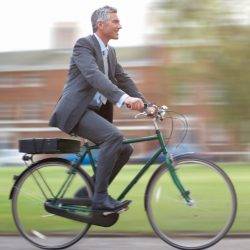November 13, 2018
Activity in leisure time does not compensate for sedentary workplace behaviour
 Employees are wrongly assuming that keeping active outside of the workplace and during leisure time will protect them from the danger of sitting for long periods when working in an office, a new study has found. The report defines an ‘active coach potato’ as a person who is physically active in their leisure time, but who also spends long periods of time sat down. Such sedentary behaviour increases the risk of chronic health issues such as diabetes, heart disease and strokes. The study is published in the scientific journal Occupational Medicine. The researchers asked 222 desk based workers and 121 managers to rate the healthiness of various combinations of sitting and physical activities during work and leisure time. They found that if a scenario included being physically active during leisure time, the employee didn’t appreciate the detrimental effect of workplace sitting alongside it.
Employees are wrongly assuming that keeping active outside of the workplace and during leisure time will protect them from the danger of sitting for long periods when working in an office, a new study has found. The report defines an ‘active coach potato’ as a person who is physically active in their leisure time, but who also spends long periods of time sat down. Such sedentary behaviour increases the risk of chronic health issues such as diabetes, heart disease and strokes. The study is published in the scientific journal Occupational Medicine. The researchers asked 222 desk based workers and 121 managers to rate the healthiness of various combinations of sitting and physical activities during work and leisure time. They found that if a scenario included being physically active during leisure time, the employee didn’t appreciate the detrimental effect of workplace sitting alongside it.
A high activity level does not eliminate the risk from prolonged sitting, yet managers failed to rate uninterrupted sitting as being unhealthy as long as minimum physical activity recommendations outside of work were met.
Traditionally there has been a focus on promoting physical activity during recreational time, however we now know that all forms of sedentary behaviour form a chronic health risk. The researchers have called on managers to promote change in the workplace.
Both managers and employees involved in the study were concerned that changes could cause disruption and could have cost implications. Putting workplace interventions into place in an inclusive and consultative way could help with this.
Study author, Dr Mussap said: “Uninterrupted sitting constitutes a substantial risk to physical and mental health. This can be problematic for desk-based workplaces where sitting is the norm. Although there is growing awareness among workers that prolonged sitting can cause problems, most of these concerns are limited to musculoskeletal health, with little awareness of the known associations between prolonged sitting and a range of cardiovascular diseases and even cancer.
“There are unfounded concerns among both employees and their managers that attempts to interrupt sitting could disrupt the workplace environment and impact negatively on productivity. There is the common yet incorrect belief that prolonged workplace sitting is not problematic if a person is physically active during their recreational time. So the problem we face as health professionals is finding ways of changing both health beliefs and health behaviours in the workplace, both in employees and employers.
“The best approaches combine health education about the risks of workplace sitting along with practical strategies for reducing or interrupting workplace sitting. The best interventions are those that change long-term habitual-type behaviours. This can be as easy as installing timed alerts or sending automated emails to remind people to move around; providing sit-stand workstations that allow workers to adjust their posture throughout the workday or organising fun group breaks where people are invited to stand up and stretch or even dance around.”














